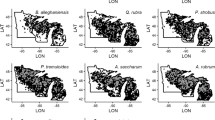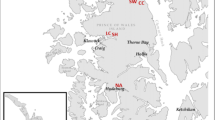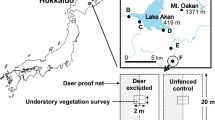Abstract
The growing populations of sika deer (Cervus nippon yesoensis) in Hokkaido, Japan, are having increasingly negative impacts on forests. Although the percentage or frequency of browsed twigs and seedlings is a useful index of the impact of deer on forests, differences in the browse preferences of deer among tree species should also be considered. We evaluated the woody browse preferences of sika deer and examined a method for evaluating deer impacts based on the occurrence of browsing scars on seedlings, together with browse preferences. We also validated the percentages of browsed seedlings irrespective of browse preferences as an index of deer impact. We measured the heights of seedlings 30–200 cm tall in five 5 × 20 m plots located in Abies sachalinensis plantations in each of seven tracts and recorded browsing damage that occurred on leader shoots of seedlings. Browse species preference was evaluated using a generalized linear model (GLM) that included the seven tracts, species, and seedling height as explanatory variables. The results of the GLM suggest that differences in browse preferences among species are continuous and cannot be categorized discretely. The tract coefficients are considered to be an index of deer impact levels and can be estimated from the percentage of browsed seedlings for a species if the species coefficient is given. Simple percentages of browsed seedlings can also be used as an index of impact level, regardless of browse preferences, though these may be inaccurate, especially when the site is dominated by significantly preferred or avoided species.



Similar content being viewed by others
References
Akashi N (2009a) Simulation of the effects of deer browsing on forest dynamics. Ecol Res 24:247–255
Akashi N (2009b) Browsing damage by sika deer on trees in young plantations and its relation to relative deer density indices in Hokkaido, Japan. J Jpn For Soc 91:178–183 (in Japanese with English abstract)
Akashi N, Unno A, Terazawa K (2011) Effects of deer abundance on broad-leaf tree seedling establishment in the understory of Abies sachalinensis plantations. J For Res 16:500–508
Akashi N, Fujita M, Watanabe O, Uno H, Ogiwara H (2013) An evaluation of the impact levels of sika deer (Cervus nippon) on natural forests using a simple check list. J Jpn For Soc 95:259–266 (in Japanese with English abstract)
Anderson RC (1994) Height of white-flowered trillium (Trillium grandiflorum) as an index of deer browsing intensity. Ecol Appl 4:104–109
Augustine DJ, de Calesta D (2003) Defining deer overabundance and threats to forest communities: from individual plants to landscape structure. Ecoscience 10:472–486
Boulanger V, Baltzinger C, Saïd S, Ballon P, Picard J-F, Dupouey J-L (2009) Ranking temperate woody species along a gradient of browsing by deer. For Ecol Manag 258:1397–1406
Castleberry SB, Ford WM, Miller KV, Smith WP (1999) White-tailed deer browse preferences in a southern bottomland hardwood forest. South J Appl For 23:78–82
Côté SD, Rooney TP, Tremblay JP, Dussault C, Waller DM (2004) Ecological impacts of deer overabundance. Annu Rev Ecol Evol Syst 35:113–147
Forsyth DM, Coomes DA, Nugent G, Hall GMJ (2002) Diet and diet preferences of introduced ungulates (Order: Artiodactyla) in New Zealand. NZ J Zool 29:323–343
Frelich LE, Lorimer CG (1985) Current and predicted long-term effects of deer browsing in hemlock forests in Michigan, USA. Biol Conserv 34:99–120
Fujiki D, Kishimoto Y, Sakata H (2010) Assessing decline in physical structure of deciduous hardwood forest stands under sika deer grazing using shrub-layer vegetation. J For Res 15:140–144
Hothorn T, Bretz F, Westfall P, Heiberger RM, Schuetzenmeister A (2013) Multcomp: simultaneous inference in general parametric models. Version 1.3-1. http://cran.r-project.org/web/packages/multcomp/
Igota H, Sakuragi M, Uno H, Kaji K, Kaneko M, Akamatsu R, Maekawa K (2004) Seasonal migration patterns of female sika deer in eastern Hokkaido, Japan. Ecol Res 19:169–178
Koda R, Fujita N (2011) Is deer herbivory directly proportional to deer population density? Comparison of deer feeding frequencies among six forests with different deer density. For Ecol Manag 262:432–439
Koh S, Bazely DR, Tanentzap AJ, Voigt DR, Da Silva E (2010) Trillium grandiflorum height is an indicator of white-tailed deer density at local and regional scales. For Ecol Manag 259:1472–1479
Kojima Y, Yasui Y, Orihashi K, Terazawa M, Kamoda S, Kasahara H, Takahashi Y (2006) Relationship between bark preferences of Cervus nippon yesoensis and inner bark components of small-diameter tree trunks. J Jpn For Soc 88:337–341 (in Japanese with English abstract)
Morellet N, Champely S, Gaillard J-M, Ballon P, Boscardin Y (2001) The browsing index: new tool uses browsing pressure to monitor deer populations. Wildl Soc Bull 29:1243–1252
Mosbacher EV, Williams CE (2009) Browse preference and browsing intensity of white-tailed deer (Odocoileus virginianus) in Allegheny high plateau riparian forests, USA. Wildl Biol Pract 5:11–21
Noguchi M, Yoshida T (2004) Tree regeneration in partially cut conifer-hardwood mixed forests in northern Japan: roles of establishment substrate and dwarf bamboo. For Ecol Manag 190:335–344
R Core Team (2014) R: A language and environment for statistical computing. R Foundation for statistical computing, Vienna, Austria. http://www.R-project.org/
Reimoser F, Putman R (2011) Impacts of wild ungulates on vegetation: costs and benefits. In: Putman R, Apollonio M, Andersen R (eds) Ungulate management in Europe: problems and practices. Cambridge University Press, Cambridge, pp 144–191
Rooney TP, Waller DM (2003) Direct and indirect effects of white-tailed deer in forest ecosystems. For Ecol Manag 181:165–176
Sakabe T, Yabe T, Yajima T, Shibuya M, Takahashi K (1998) Tree damage by sika deer in a wintering area in the Iwaobetsu district on the Shiretoko peninsula. Res Bull Hokkaido Univ For 55:113–122 (in Japanese with English abstract)
Sakuragi M, Igota H, Uno H, Kaji K, Kaneko M, Akamatsu R, Maekawa K (2003) Seasonal habitat selection of an expanding sika deer Cervus nippon population in eastern Hokkaido, Japan. Wildl Biol 9:141–153
Suzuki M, Fujimaki A, Kamoda S, Maehara T, Saito H, Matsui M, Iguchi K, Kaji M, Kamata N (2011) Factors affecting the probability of bark-stripping by deer in a natural forest: an analysis based on tree characteristics, deer habitat utilization and environmental conditions. J Jpn For Soc 93:213–219 (in Japanese with English abstract)
Sweetapple PJ, Nugent G (2004) Seedling ratios: a simple method for assessing ungulate impacts on forest understories. Wildl Soc Bull 32:137–147
Takahashi Y, Inukai M, Iguchi K, Takahashi I, Yamamoto H (1997) A case of forest damage caused by sika deer (Cervus nippon yesoensis Heude) in Iwanazawa experimental plot of the Tokyo University Forest in Hokkaido. Trans Mtg Hokkaido Br Jap For Soc 45:84–86 (in Japanese)
Takatsuki S (2009) Effects of sika deer on vegetation in Japan: a review. Biol Conserv 142:1922–1929
Takayanagi A, Furumoto H, Watanabe Y, Sato S, Matsushita K, Ito T (1991) Deer barking in Shiranuka district of Kyoto University Forest in Hokkaido. Rep Kyoto Univ For 22:13–27 (in Japanese)
Toyooka K, Sato A, Ishizuka S (1983) The distribution map of Sasa group in Hokkaido. Hokkaido Branch, Forest Products Research Institute, Sapporo, Japan (in Japanese)
Umeki K, Kikuzawa K (1999) Long-term growth dynamics of natural forests in Hokkaido, northern Japan. J Veg Sci 10:815–824
Uno H, Kaji K (2000) Seasonal movements of female sika deer in eastern Hokkaido, Japan. Mammal Study 25:45–57
Uno H, Kaji K, Saitoh T, Matsuda H, Hirakawa H, Yamamura K, Tamada K (2006) Evaluation of relative density indices for sika deer in eastern Hokkaido, Japan. Ecol Res 21:624–632
Yamamura H, Matsuda H, Yokomizo H, Kaji K, Uno H, Tamada K, Kurumada T, Saitoh T, Hirakawa H (2008) Harvest-based bayesian estimation of sika deer populations using state-space models. Popul Ecol 50:131–144
Acknowledgments
This work was supported by JSPS KAKENHI Grant Number 25450222 and the Mitsui & Co., Ltd. Environment Fund for the project “Development of assessment method on impacts by sika deer to natural vegetation for ecosystem management”.
Author information
Authors and Affiliations
Corresponding author
About this article
Cite this article
Akashi, N., Unno, A. & Terazawa, K. Significance of woody browse preferences in evaluating the impact of sika deer browsing on tree seedlings. J For Res 20, 396–402 (2015). https://doi.org/10.1007/s10310-015-0492-3
Received:
Accepted:
Published:
Issue Date:
DOI: https://doi.org/10.1007/s10310-015-0492-3




